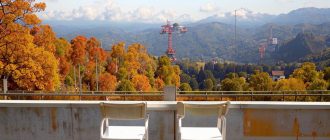If you or your kids are very fond of skateboarding, why not build a skate ramp right at your cottage? Of course, if you have the space and resources to do so. Today, we’ll tell you what’s important to consider when building your ramp to make sure it’s perfect.

founder of the skatepark construction company “Tsekh”
You can build a mini skate ramp out of metal and even concrete, but let’s take the best option – wood (board and plywood). This is the easiest, fastest and most economical way.
Where to start
To begin with, you need to decide on the dimensions. This depends on a few factors: what you ride and what level you are at. If you are a beginner or have little experience, I would recommend building a ramp no more than 0.7 meters high. It is also ideal for children. You can choose the width based on your budget and available space.
Usually the width of a mini ramp is calculated from the size of a sheet of plywood. That is, the width will be a multiple of 1.2 meters. The minimum width is better to make 2.4 meters. The length of such a mini-frame is from 6.5 to 8.5 meters.
If you want to enjoy the sound of grinds (slides), add 1.2 meters.
If you are an experienced rider, you can install a multi-level ramp. This will add variety to your riding and your skills will grow faster. All these parameters are more suitable for skateboard, entry level rollerblading and scooter. For BMX, the dimensions need to be much larger.

Build it yourself or hire professionals?
So, you have decided on a place on the plot, drew a rough sketch, as it allows you to draw a high school drafting skill, and estimated the cost of materials with logistics. Now you have two options: actually build everything yourself or order from a company that can build the ramp for you.
Denis: I’m more in favor of the second option. The process of building a ramp is like building a house or even a bed. You can figure out the material, find the tools and start experimenting. In the end, you may end up spending a lot of time (although it will be fun, plus you will get experience) and money (because the initial calculation may be wrong), and not at all the fact that you will like the final result.
How to build a ramp yourself
If you want to do it all yourself, the methodology should be roughly as follows:
- First, show your sketches to people who know a lot about skating. This way you can see the flaws in the design, and maybe even revise the concept completely;
- Go to a skateboarding or scooter competition and compare a professionally built ramp to your own. You may be missing something. In addition, you’ll be able to understand what materials it’s made of. And the “full house” plan will be if you get to talk to the builders of that park;
- don’t skimp on materials. Skateboarding, scootering, rollerblading or BMX riding is a difficult activity to predict, and it’s better if you have a higher margin of safety in the construction;
- the moment you buy materials at the store or market, you can give them straight to the sawing. But be prepared that this will still not save you from “fitting” the parts to each other during construction;
- it makes sense to impregnate and protect the wooden parts of your future ramp with various compounds that will help to avoid sudden fire, deformation or corrosion;
- at each stage (whether it is the foundation, installation of the base, construction of radii and covering with plywood) it is better to double-check the dimensions, bends and joints;
- you will definitely need a professional rider or park builder to lay out the correct radii. The safety and comfort of your riding depends on how competently this value is calculated;
- take your time: if this is your “first” ramp, it is better to spend more time on it;
- the frame is of two types: from a bar or from plywood. Lintels, as a rule, are made of planks, and plywood, 9 mm or 12 mm thick, is laid on top. All sheets should be tightly fitted to each other so that there are no joints greater than 3 mm and no more than 1-2 mm in height. For cooping (slip tube) a 57 mm diameter pipe is used;
- to soothe the soul and harmonize the design, the ramp can be painted;
- it is best to install the mini ramp on a flat and hard surface (concrete, asphalt, tile). If you have a lawn or the ground, it is also okay, you can put foam blocks underneath;
- to make the mini ramp stand longer, you need to impregnate the board with fire retardant, and use laminated plywood with mesh corrugation of the 1st grade, so that it is not slippery. You can also put it on a very small slope so that water can run off.

Denis: The main mistakes and shortcomings in the construction of mini-frames – the use of low-quality materials (plywood, self-tapping screws), incorrect radii (usually very sharp) and in general the proportions of the figure (long transit, for example).
Builder’s Tip. If you decide to trust professionals, when choosing a company, be sure to look at previously made similar projects. Some are oriented only on the price, but this is not quite right. Often people buy and put “cheaper but bigger”, and then afraid to ride in such a ramp. After a couple of seasons the mini ramp starts to rot, fall apart and in the end only takes up space. A couple of beautiful photos for social networks does not justify its purpose.
There is no need to take care of the mini-frame, just sometimes check the reliability of fasteners and self-tapping screws. Nothing should dangle or stick out.
If you are a big fan of building something from scratch and a fan of skateboarding, why not try to make your own board? Read more about what you need to consider and what parts to buy here.






